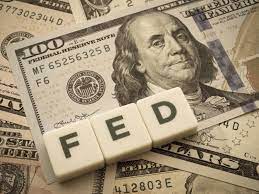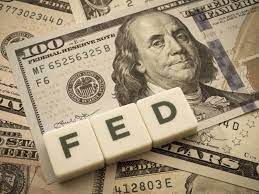
The US dollar fell on Thursday following the announcement of the US Federal Reserve that its fight against high inflation was coming to an end which raised hopes among market participants that the central bank's campaign of rate-hike to tame inflation was to come to an end soon.
Following Fed Chair Jerome Powell's comments on Wednesday that "the disinflationary process has begun" in the largest economy of the world, investors remained relatively subdued because Powel had also previously indicated that the policy of hike in interest rates would be maintained by the Fed and the central bank had no plans on cutting down on the rate hike policy.
The Fed's statement on Wednesday, issued following the end of a two-day policy meeting wherein policymakers affirmed to the proposal to raise rates by 25 basis points, was the central bank's first explicit acknowledgement of a slowdown of high inflation rates.
Following Powell's remarks, the US dollar plummeted. On Wednesday, the US dollar index dropped to a new nine-month low of 100.80 against a basket of currencies. It was last down 0.07% at 100.88, having dropped more than 1% on Wednesday.
"It was very much a sort of relief ... that there was nothing there to really seriously challenge the market's prevailing view," said Ray Attrill, head of FX strategy at National Australia Bank (NAB).
"(Powell) said that rates are going to have to be restrictive for some time, but that doesn't dissuade the market from saying some time might be six months, rather than two years."
The Australian dollar hit an eight-month high of $0.7158 in early Asia trade on Thursday, and it last traded at $0.7150, up 1.2% from the previous session.
The kiwi also reached an eight-month high of $0.65365 after rising more than 1% on Wednesday.
The dollar fell more than 0.5% against the Japanese yen to a session low of 128.17.
With the Fed out of the way, the European Central Bank (ECB) and the Bank of England (BoE) are set to announce interest rate decisions later on Thursday. Each is expected to raise rates by 50 basis points.
On Thursday, the euro reached a roughly 10-month high of $1.1034 and was last 0.3% higher at $1.1023, while sterling rose 0.14% to $1.1023.
"The risk is that we get a hawkish 50 from the ECB and a dovish 50 from the Bank of England. That might create some volatility," said NAB's Attrill.
In the eurozone, inflation fell for the third month in a row in January, according to data released on Wednesday. However, any relief for the ECB may be limited, as underlying price growth has remained stable, and questions have already been raised about the figures' reliability.
"In Europe, the inflation pressure remains very high despite the drop in energy prices," said Tareck Horchani, head of prime brokerage dealing at Maybank Securities.
"We should see (the) ECB continue hiking interest rates until at least the end of Q1 2023."
In the United States, Friday's nonfarm payrolls report will be the next litmus test for the Federal Reserve's fight against inflation, despite official data on Wednesday showing that job openings unexpectedly increased in December, indicating a still-tight labor market.
Markets now expect the Fed funds rate to peak at just under 4.9% by June, versus earlier expectations of a peak at just under 5%.
(Source:www.theprint.in)
Following Fed Chair Jerome Powell's comments on Wednesday that "the disinflationary process has begun" in the largest economy of the world, investors remained relatively subdued because Powel had also previously indicated that the policy of hike in interest rates would be maintained by the Fed and the central bank had no plans on cutting down on the rate hike policy.
The Fed's statement on Wednesday, issued following the end of a two-day policy meeting wherein policymakers affirmed to the proposal to raise rates by 25 basis points, was the central bank's first explicit acknowledgement of a slowdown of high inflation rates.
Following Powell's remarks, the US dollar plummeted. On Wednesday, the US dollar index dropped to a new nine-month low of 100.80 against a basket of currencies. It was last down 0.07% at 100.88, having dropped more than 1% on Wednesday.
"It was very much a sort of relief ... that there was nothing there to really seriously challenge the market's prevailing view," said Ray Attrill, head of FX strategy at National Australia Bank (NAB).
"(Powell) said that rates are going to have to be restrictive for some time, but that doesn't dissuade the market from saying some time might be six months, rather than two years."
The Australian dollar hit an eight-month high of $0.7158 in early Asia trade on Thursday, and it last traded at $0.7150, up 1.2% from the previous session.
The kiwi also reached an eight-month high of $0.65365 after rising more than 1% on Wednesday.
The dollar fell more than 0.5% against the Japanese yen to a session low of 128.17.
With the Fed out of the way, the European Central Bank (ECB) and the Bank of England (BoE) are set to announce interest rate decisions later on Thursday. Each is expected to raise rates by 50 basis points.
On Thursday, the euro reached a roughly 10-month high of $1.1034 and was last 0.3% higher at $1.1023, while sterling rose 0.14% to $1.1023.
"The risk is that we get a hawkish 50 from the ECB and a dovish 50 from the Bank of England. That might create some volatility," said NAB's Attrill.
In the eurozone, inflation fell for the third month in a row in January, according to data released on Wednesday. However, any relief for the ECB may be limited, as underlying price growth has remained stable, and questions have already been raised about the figures' reliability.
"In Europe, the inflation pressure remains very high despite the drop in energy prices," said Tareck Horchani, head of prime brokerage dealing at Maybank Securities.
"We should see (the) ECB continue hiking interest rates until at least the end of Q1 2023."
In the United States, Friday's nonfarm payrolls report will be the next litmus test for the Federal Reserve's fight against inflation, despite official data on Wednesday showing that job openings unexpectedly increased in December, indicating a still-tight labor market.
Markets now expect the Fed funds rate to peak at just under 4.9% by June, versus earlier expectations of a peak at just under 5%.
(Source:www.theprint.in)





